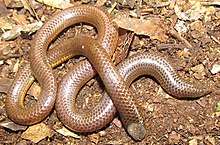Rhinophis goweri
Rhinophis goweri, also known as Gower's shieldtail snake, is a recently described, little-known species of snake of the family Uropeltidae. It is endemic to the Eastern Ghats of Tamil Nadu in South India.[1][2][3]
| Rhinophis goweri | |
|---|---|
 | |
| Scientific classification | |
| Kingdom: | Animalia |
| Phylum: | Chordata |
| Class: | Reptilia |
| Order: | Squamata |
| Suborder: | Serpentes |
| Family: | Uropeltidae |
| Genus: | Rhinophis |
| Species: | R. goweri |
| Binomial name | |
| Rhinophis goweri Aengals & Ganesh, 2013 | |
Description
Rhinophis goweri can be identified by the following combination of characters: midbody scale rows 17; convex caudal shield as long as or longer than shielded part of head; rostral not more than half as long as shielded part of head, separating prefrontal scales for more than half their length; ventral scales 215; venter and outermost scale rows without large spots; uniform dark grayish brown above and off-white heavily powdered with brown below; tail distinctly reddish orange below; dorsum uniform and unpatterned.[4][5]
Etymology
This species was named after Dr. David Gower, a herpetologist with the Natural History Museum, London, for his work on these snakes.[1]
Geographic range
This species was first described from Bodha Malai bordering Namakkal and Salem district of Tamil Nadu state. Later, surveys in other hills of Eastern Ghats revealed its presence in Kolli Hills, in Namakkal district.[6]
Habits and habitat
This species is slow-moving, nocturnal, fossorial, and lives in the tropical wet forests covering the higher slopes (>900 m (3,000 ft) asl) of the hills. It is thought to feed on earthworms like other snakes of the family Uropeltidae. It becomes more active during monsoon. It has been recorded from an elevation of up to 1,370 m (4,490 ft) asl, atop Kolli Hills in dense forests as well as coffee and pineapple plantations and mixed fruit orchards.[6]
References
- Rhinophis goweri at the Reptarium.cz Reptile Database. Accessed 31 January 2019.
- "347 flora, 242 fauna species discovered in 2013-14: Environment Minister Prakash Javadekar". The Economic Times. India: The Economic Times. 2015-08-11. Retrieved 2019-01-19.
- Singh, Shiv Sahay (2014-07-13). "India logged 248 new species in 2013". The Hindu. India: The Hindu. Retrieved 2019-01-19.
- Aengals, R. & S. R. Ganesh (2013). "Rhinophis goweri — A new species of shieldtail snake from the Southern Eastern Ghats, India". Russian Journal of Herpetology. 20 (1): 61–65.
- Pyron, R. A.; Ganesh, S. R.; Sayyed, A.; Sharma, V.; Wallach, V. & Somaweera, R. (2016). "A catalogue and systematic overview of the shield-tailed snakes (Serpentes: Uropeltidae)" (PDF). Zoosystema. 38 (4): 453–506.
- Ganesh, S. R. & M. Arumugam (2016). "Species richness of montane herpetofauna of southern Eastern Ghats, India: A historical resume and a descriptive checklist". Russian Journal of Herpetology. 23 (1): 7–24.